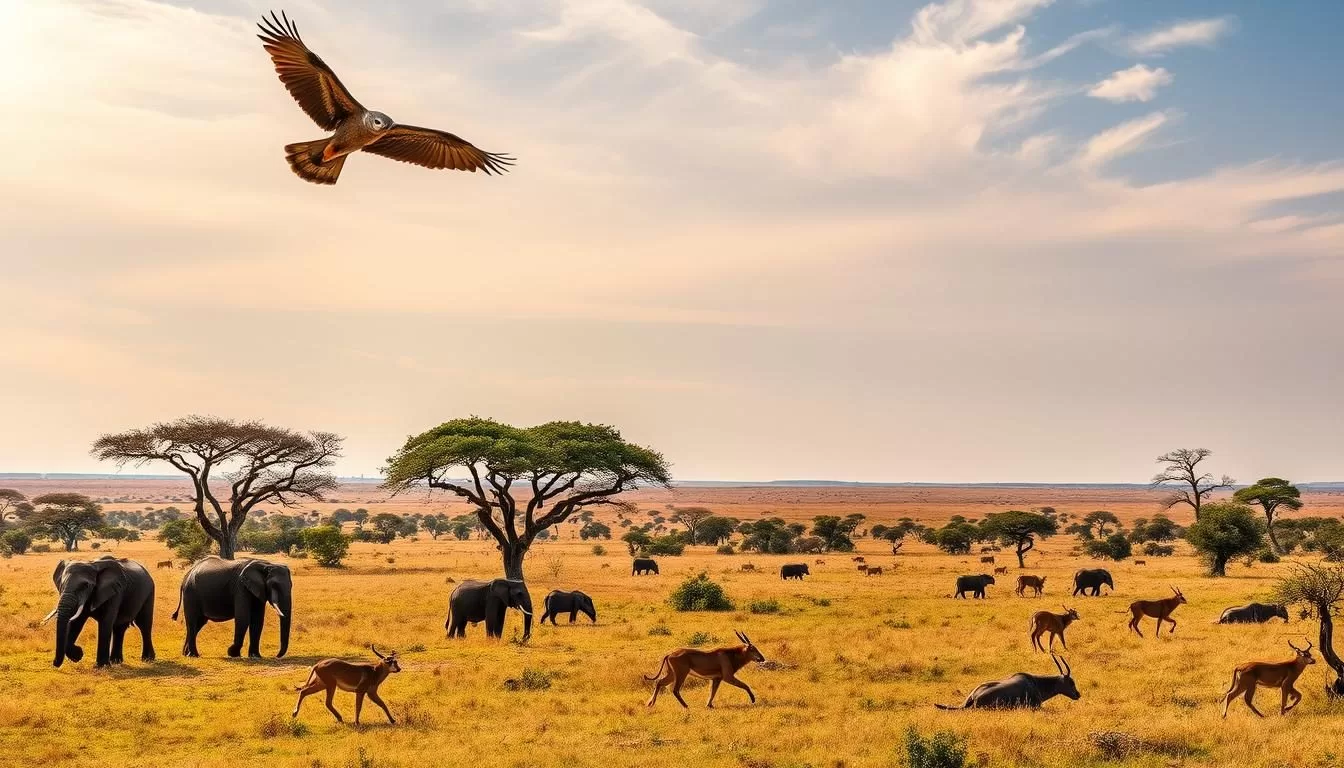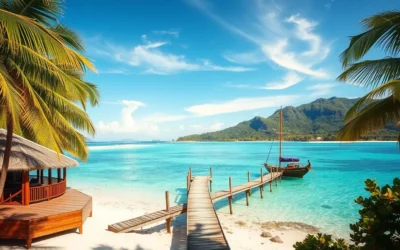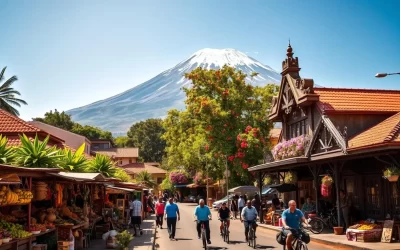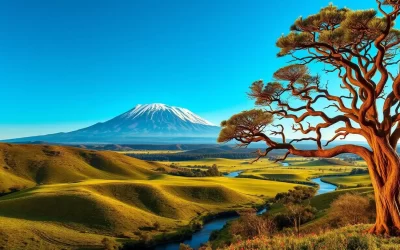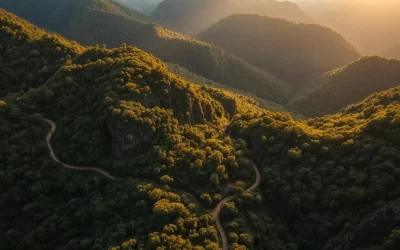Imagine witnessing the greatest wildlife show on earth, the Great Wildebeest Migration, in a pristine savanna teeming with over a million animals. You’re about to embark on an adventure of a lifetime in one of Africa’s most iconic safari destinations.
Serengeti National Park stands as Tanzania’s flagship conservation area, offering unparalleled wildlife viewing opportunities. As you explore this vast, untouched landscape, you’ll have the chance to witness the spectacular migration and experience the rich cultural heritage of the region.
This comprehensive guide will walk you through the highlights of your trip to Serengeti, covering the top activities and experiences that make this national park a world-renowned destination. Whether you’re planning your first safari or returning to experience more, get ready to explore the wonders of this incredible wildlife sanctuary.
Discovering the Magic of Serengeti National Park
The Serengeti, with its endless plains and rich biodiversity, stands as a testament to the wonders of African wildlife. As you explore this magnificent national park, you’re treated to an experience like no other, with opportunities for exceptional game viewing and wildlife encounters.
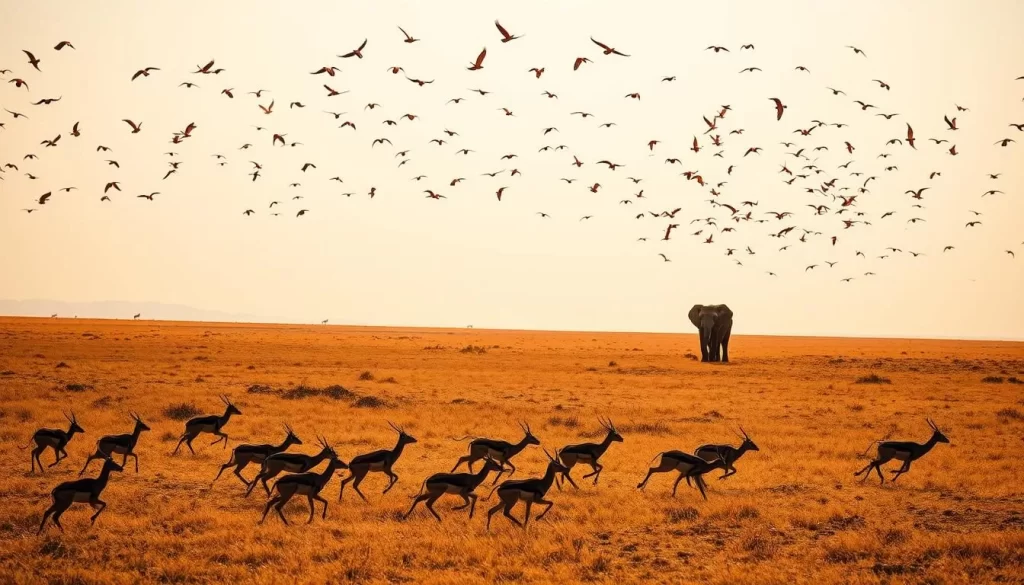
The Endless Plains of Tanzania
Serengeti National Park is renowned for its vast, untouched savannas that stretch as far as the eye can see. This Tanzanian treasure is home to more than a million animals, creating a diverse ecosystem that’s a marvel to behold. The park’s unique landscape and geography support a wide range of habitats, from grasslands to woodlands, making it an ideal location for a safari tour.
Why Serengeti Ranks Among the World’s Best Safari Destinations
Serengeti National Park consistently ranks among the world’s top safari destinations due to its extraordinary concentration of wildlife and pristine, protected ecosystem. The park is famous for hosting the largest terrestrial mammal migration on Earth—the Great Wildebeest Migration—where over 1.5 million wildebeest and 200,000 zebras migrate in search of fresh grazing. This spectacle, combined with the park’s high density of large predators, including lions, leopards, cheetahs, and hyenas, offers visitors an unparalleled viewing experience.
With its well-developed tourism infrastructure, Serengeti provides a comfortable and enriching experience for visitors, ranging from budget-friendly options to luxury lodges. Whether you’re a seasoned traveler or on your first safari adventure, Serengeti National Park promises an unforgettable journey into the heart of Africa’s wildlife haven.
Planning Your Perfect Serengeti Safari Adventure
Embarking on a Serengeti safari adventure requires meticulous planning to ensure an unforgettable experience. With its vast plains and diverse wildlife, Serengeti National Park offers a unique safari experience that can be tailored to suit various interests and preferences.
Best Times to Visit Serengeti National Park
Understanding the best time to visit Serengeti is crucial for maximizing your wildlife viewing opportunities. The park is known for the Great Migration, a spectacle that varies by season.
The Great Migration typically occurs between December and July, with the exact timing dependent on rainfall patterns. For those interested in witnessing the dramatic river crossings, visiting between July and August can be particularly rewarding.
| Season | Best For | Highlights |
|---|---|---|
| December to March | Calving season | Newborn wildebeest, predator activity |
| April to July | Migration | Wildebeest migration, river crossings |
| August to November | Dry season | Concentrated wildlife around water sources |
How Many Days to Spend in Serengeti
Determining the ideal length of your trip to Serengeti depends on your interests and what you want to achieve from your safari tour. A minimum of 3-4 days is recommended to properly explore the park and enjoy quality wildlife viewing.
For those with a specific interest, such as photography or witnessing the migration, 5-7 days can provide the necessary flexibility to capture the perfect shot or experience the migration without feeling rushed.
Game Drives: The Ultimate Serengeti Experience
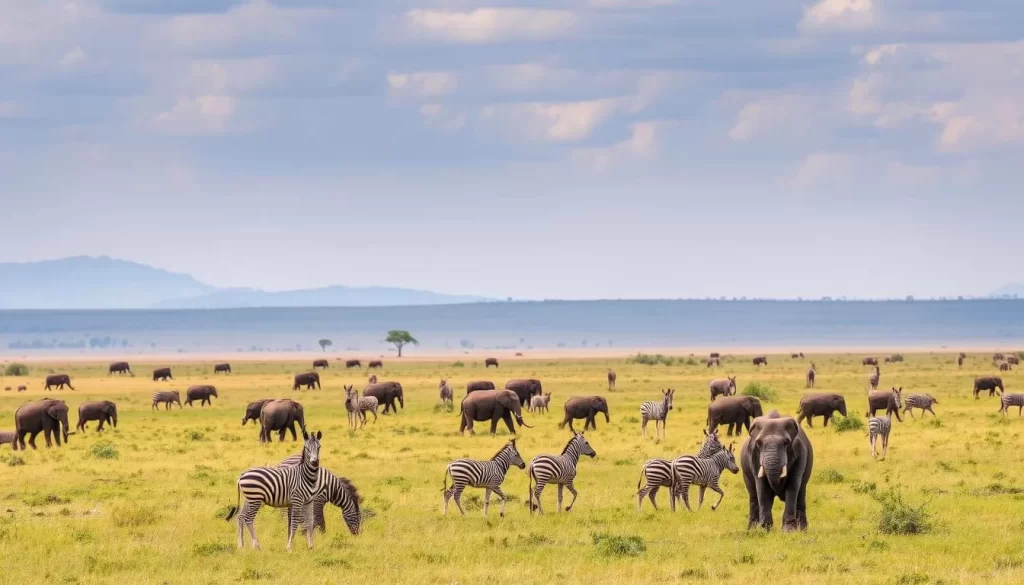
The Serengeti’s endless plains are best explored through game drives, an adventure that brings you face-to-face with nature’s wonders. As you venture into the park, the thrill of spotting diverse wildlife in their natural habitat is an exhilarating experience.
Morning Game Drives: Prime Wildlife Viewing
Starting your day early with a game drive allows you to witness the Serengeti’s wildlife during their most active hours. The morning light casts a golden glow over the landscape, making it an ideal time for photography and observing animals as they roam freely.
Afternoon Safari Adventures
An afternoon safari in the Serengeti offers a different yet equally captivating experience. As the day warms up, different species become more active, providing a unique perspective on the park‘s diverse fauna. It’s a great opportunity to spot predators and understand their behavior.
Full-Day Game Drives for Maximum Wildlife Exposure
For those seeking an immersive experience, full-day game drives are the way to go. Spending the entire day on the plains allows you to witness the full spectrum of wildlife activities, from grazing to hunting. It’s a comprehensive way to understand the ecosystem of the Serengeti.
Night Game Drives: Spotting Nocturnal Creatures
Night game drives offer a completely different perspective of the Serengeti, revealing the park‘s nocturnal residents. Using spotlights with red filters to avoid disturbing animals, guides help you spot elusive nocturnal species. The night drives provide rare opportunities to witness predators actively hunting under the cover of night darkness, adding an extra dimension of excitement to your safari experience. The sounds of the African night create an unforgettable atmosphere, making it a unique drive through the Serengeti.
Witness the Great Wildebeest Migration
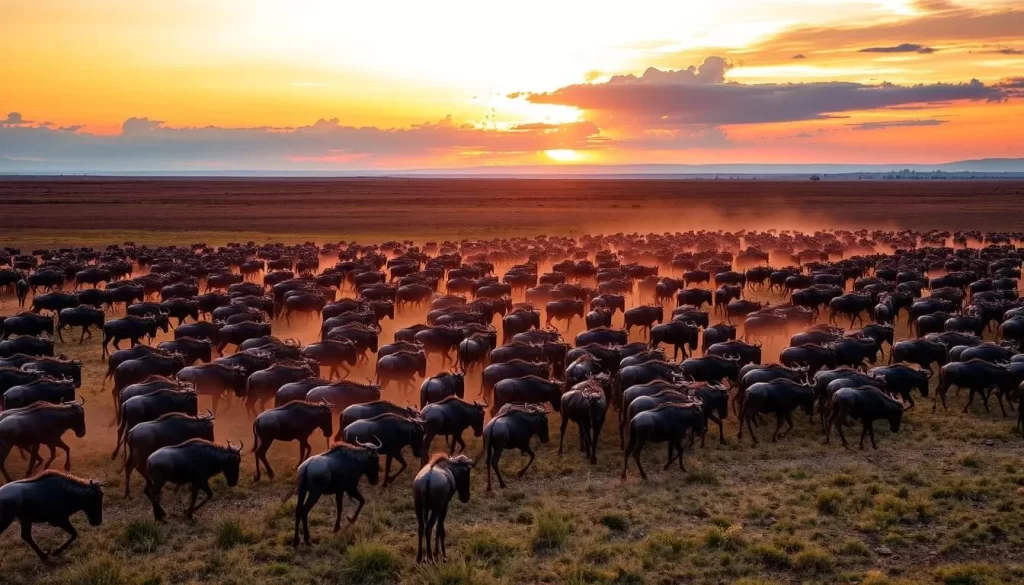
The Serengeti’s Great Wildebeest Migration is an awe-inspiring event that captivates visitors from around the world. This natural spectacle involves over a million wildebeest, zebras, and gazelles making their way across the Serengeti in search of greener pastures.
Understanding the Migration Cycle
The Great Wildebeest Migration follows a cyclical pattern, influenced by the seasons. Timing is crucial when planning to witness this event. If you’re looking to visit during this once-in-a-lifetime event, aligning your visit between June and July is recommended, although the exact timing may vary from year to year.
To maximize your chances of witnessing the migration, it’s essential to coordinate with your safari tours. For a bird’s-eye view of the migration, consider a hot air balloon ride, which offers a unique perspective on this natural wonder.
Best Locations to View the Migration by Season
The location of the migration varies by season. Here are the key locations and times to witness this phenomenon:
- December to March: The southern plains of Serengeti, particularly the Ndutu area, host the migration during calving season.
- April to May: The herds move northward through the central Serengeti, specifically the Seronera area.
- June to July: The Western Corridor is where dramatic river crossings occur, notably at the Grumeti River.
- July to October: The Northern Serengeti and Mara River area become the focal points, featuring famous river crossings.
- November: The herds begin their southward journey back through the eastern Serengeti.
Understanding these seasonal movements will help you plan your Serengeti safari to coincide with the migration, ensuring an unforgettable experience.
Soar Above the Plains: Hot Air Balloon Safaris
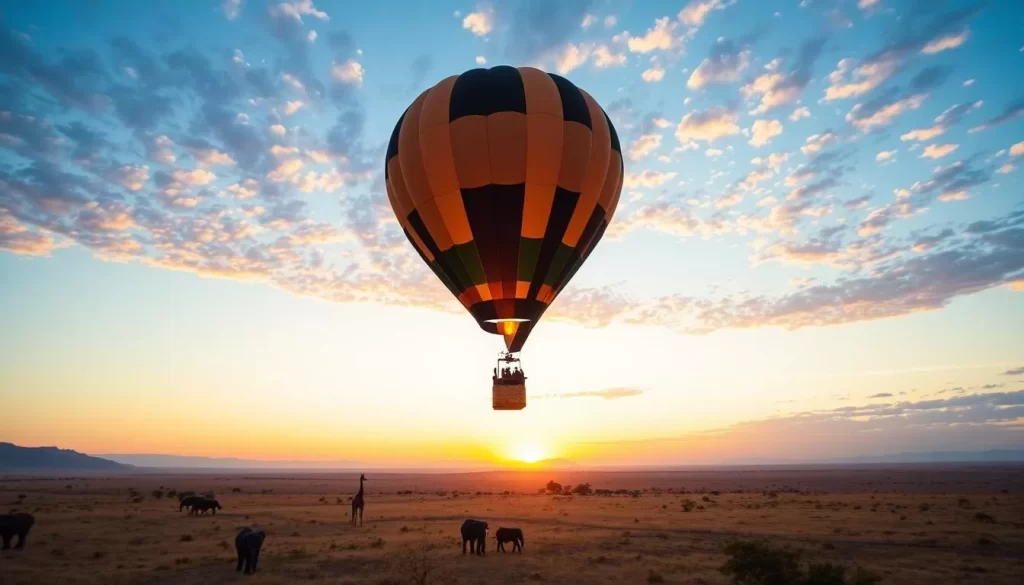
Experience the Serengeti like never before with a hot air balloon safari. This unique adventure allows you to witness the breathtaking beauty of the Serengeti from above, providing a new perspective on this incredible ecosystem.
What to Expect During Your Balloon Safari
Hot air balloon safaris in Serengeti National Park are conducted in three sectors: the central Seronera part, the Northern Serengeti Maasai Mara circuit, and the Southern Ndutu sector. These morning flights are determined by the day’s weather and can last between one to four hours, starting as early as 6 o’clock and concluding with a bush breakfast around 9 to 10 am.
If you’re visiting during the Great Wildebeest Migration, a hot air balloon ride is a must. It’s the best way to experience the migration from above, offering a unique perspective on this natural wonder.
Tips for the Best Balloon Safari Experience
To make the most of your hot air balloon safari, consider the following tips:
- Book your balloon safari well in advance (at least 3-6 months), especially during peak season or to witness the Great Wildebeest Migration.
- Dress in layers for the morning chill and rising temperatures, opting for neutral colors like browns, greens, and khakis.
- Bring a camera with extra batteries and memory cards, securing it with a strap, and consider a zoom lens for wildlife and a wide-angle lens for landscapes.
- Listen carefully to your pilot’s instructions, as landings can be bumpy depending on wind conditions.
- If you’re prone to motion sickness, take medication before the flight, though most people find balloon rides smooth and gentle.
Birding Paradise: Spotting Serengeti’s Feathered Residents
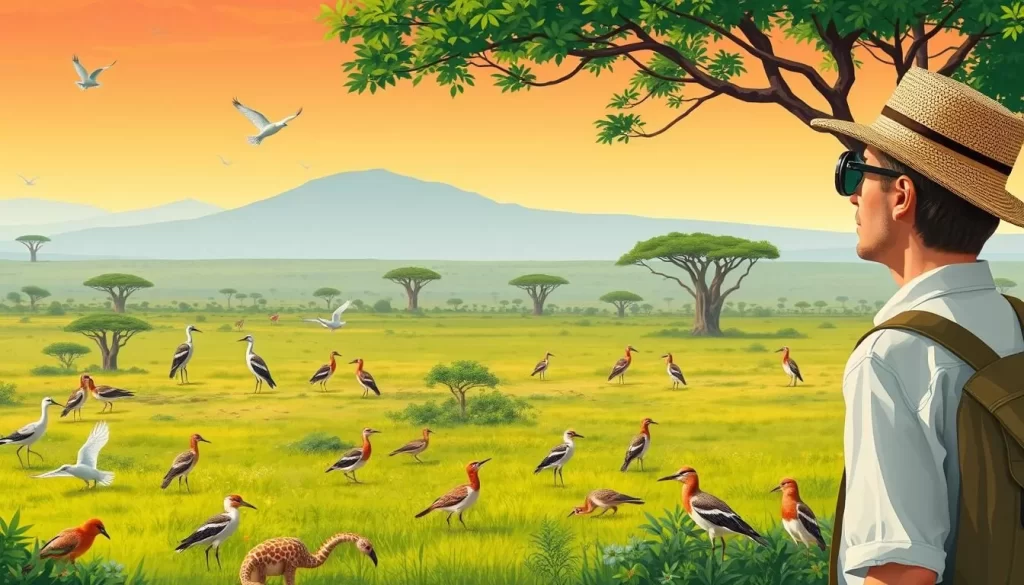
As you explore the Serengeti National Park, you’ll discover a birding paradise teeming with a diverse array of feathered residents. The Serengeti’s diversified ecosystem has added an advantage to the park, harboring different kinds of birds from open savannah to the small dotted shrubs in the north and the hills surrounding the park, which inhabits different bird species.
The Serengeti ecosystem is divided into several regions, including the Seronera central area, Ikorongo reserve, Ngorongoro famed conservation sector, Grumeti area, and the Loliondo area. Birding in Serengeti can be done throughout the year, though the most recommended months are from November to April, which is a breeding period for most of the birds.
Top Bird Species to Look For
Serengeti is home to a wide variety of bird species. Some of the top bird species to look out for include kingfishers, herons, fish eagles, African Finfoot, Giant Kingfisher, Verreaux’s Eagle, Mocking Cliff Chat, and various sunbirds. The park’s diverse habitats support ground-dwelling species like bustards, korhaans, larks, and pipits.
Best Birding Locations in Serengeti
The Serengeti offers several excellent birding locations. The Seronera River area in Central Serengeti offers excellent year-round birding with its permanent water sources. The Western Corridor’s Grumeti River provides habitat for water-loving species, especially during the dry season. The Northern Serengeti’s Lobo area combines woodland and rocky outcrops, creating diverse habitats that support a range of species.
Exploring Different Regions of Serengeti National Park
As you venture into Serengeti National Park, you’ll discover that it’s not just a single, uniform landscape, but rather a diverse array of ecosystems and regions, each with its unique charm and wildlife viewing opportunities. The park’s varied landscapes support a wide range of wildlife, making it one of Africa’s premier safari destinations.
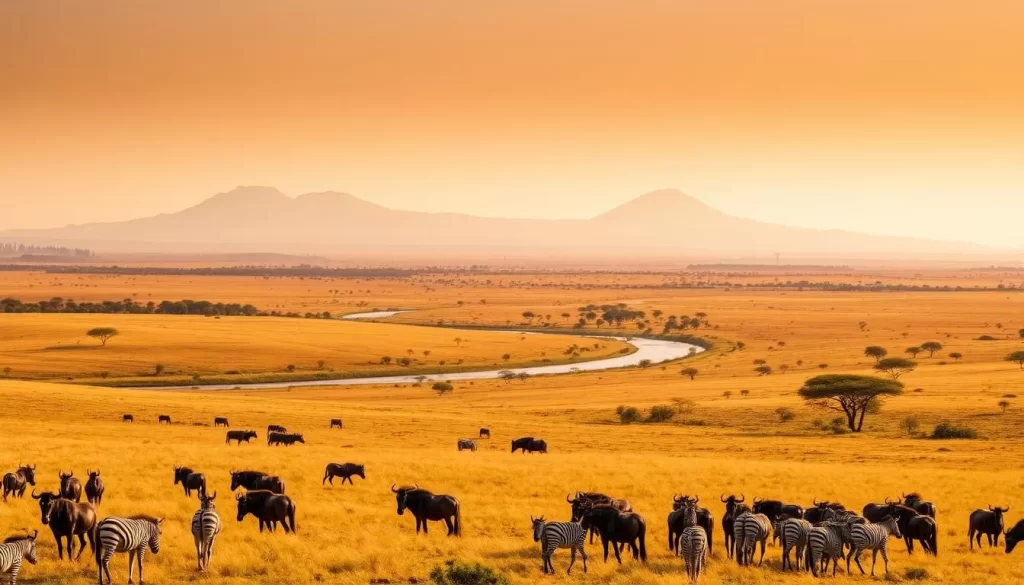
Central Serengeti (Seronera Area)
The Central Serengeti, around the Seronera Area, is known for its rich wildlife and is often considered the heart of the park. This region is characterized by its granite outcrops, known as kopjes, which provide habitat for a variety of animals. You can expect to see a high concentration of predators, including lions and leopards, as well as large herds of herbivores like wildebeest and zebras.
Northern Serengeti and Mara River
Northern Serengeti is marked by the iconic Mara River, which plays a crucial role in the Great Wildebeest Migration. The river’s crossings are a highlight of the migration cycle, attracting predators and offering dramatic scenes. The area is also home to diverse wildlife, including elephants, giraffes, and various antelope species. The lush riverine forests and open plains make it a visually stunning region.
Southern Serengeti and Ndutu Area
The Southern Serengeti and Ndutu Area are known for their short grasslands, which attract large herds of wildebeest and zebras. This region is particularly significant during the calving season, typically from January to March, when thousands of wildebeest give birth. The area’s open plains and lack of vegetation make it ideal for spotting wildlife, including the Big Five.
Western Corridor and Grumeti River
The Western Corridor, stretching towards Lake Victoria, is characterized by its riverine forests along the Grumeti River and rolling hills with acacia woodlands. This region becomes a focal point during the migration in May and June, as wildebeest herds cross the crocodile-infested Grumeti River. The water in the Grumeti River supports massive Nile crocodiles, making it a dramatic spot during the migration. Outside of migration season, the area offers excellent game viewing, with resident wildlife including buffalo herds and giraffes.
Serengeti National Park, Tanzania: Best Things to Do – Top Picks for Wildlife Enthusiasts
For anyone passionate about wildlife, Serengeti National Park in Tanzania is a top destination. The park offers a diverse range of wildlife experiences that cater to all interests and preferences. As you explore the Serengeti, you’ll have the opportunity to witness an incredible array of animals in their natural habitat.
Big Cat Encounters: Lions, Leopards, and Cheetahs
The Serengeti is renowned for its big cat population, including lions, leopards, and cheetahs. Lions are often seen in the Seronera region, where multiple prides roam the grasslands and rocky outcrops. Leopards, on the other hand, are more elusive and require a keen eye to spot, as they are masters of camouflage. Cheetahs, the fastest land animal, can sometimes be seen stalking their prey across the open plains.
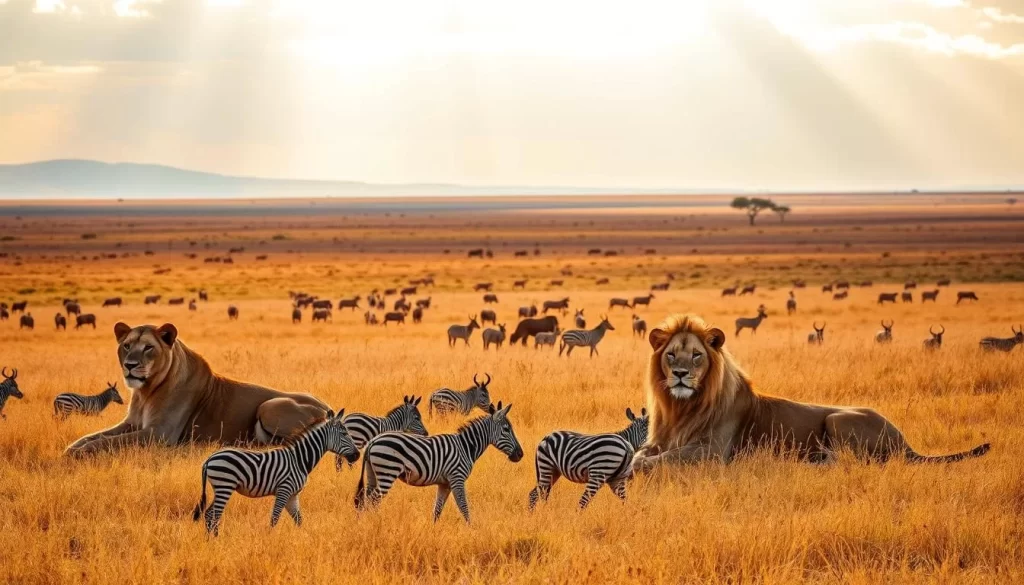
Tracking the “Big Five” in Serengeti
The “Big Five” – lion, leopard, elephant, buffalo, and rhinoceros – are a highlight of any safari experience in the Serengeti. These animals were originally considered the most challenging and dangerous to hunt on foot, but now they represent a thrilling wildlife viewing checklist for visitors.
| Big Five Animal | Habitat | Viewing Tips |
|---|---|---|
| Lion | Grasslands and rocky outcrops | Look for prides in the Seronera region |
| Leopard | Woodland areas and rocky outcrops | Be patient and keep a keen eye out |
| Elephant | Woodland areas and near rivers | Often seen in family groups |
| Buffalo | Throughout the park, near water sources | Commonly seen in large herds |
| Rhinoceros | Protected areas | Rare and require a guided tour |
By understanding the habitats and behaviors of these magnificent creatures, you can enhance your game viewing experience in the Serengeti National Park.
Cultural Experiences Near Serengeti
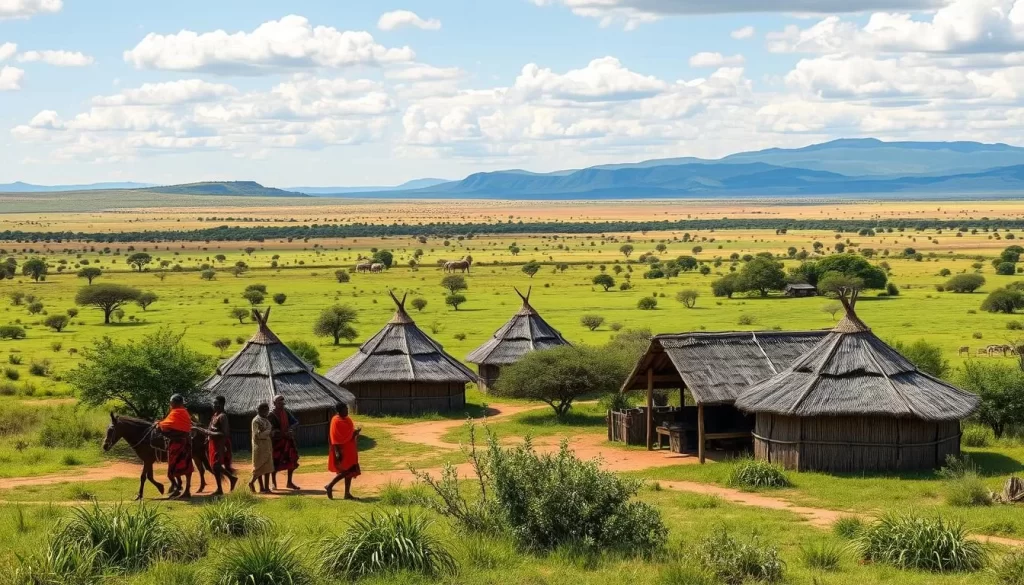
Beyond the endless plains, Serengeti offers a chance to engage with the vibrant traditions of the Maasai people. The name “Serengeti” itself is derived from the Maasai language, meaning “endless plains,” which perfectly encapsulates the vast landscapes you can explore.
Visiting Maasai Villages
Visiting a Maasai village is a unique cultural experience that allows you to learn about the traditional ways of life of these iconic Tanzanian people. During your trip to the village, you can witness traditional dances, understand the significance of different customs, and even participate in some activities.
Learning About Local Traditions and Customs
The region around Serengeti National Park is rich in cultural heritage. You can experience this firsthand by visiting cultural centers that offer demonstrations of traditional music and dance. Moreover, learning about the traditional ecological knowledge of the local communities can provide insights into sustainable living practices in harmony with nature. Guided walking tours with local trackers can also enhance your understanding of how indigenous communities have interpreted animal behavior and used natural resources for generations.
By engaging in these cultural experiences, you not only enrich your tour but also contribute to the preservation of local traditions and customs, making your visit a meaningful experience in and around the national park.
Where to Stay in Serengeti National Park
When planning your Serengeti adventure, choosing the right accommodation is crucial for a memorable experience. Serengeti National Park offers various options to suit different preferences and budgets.
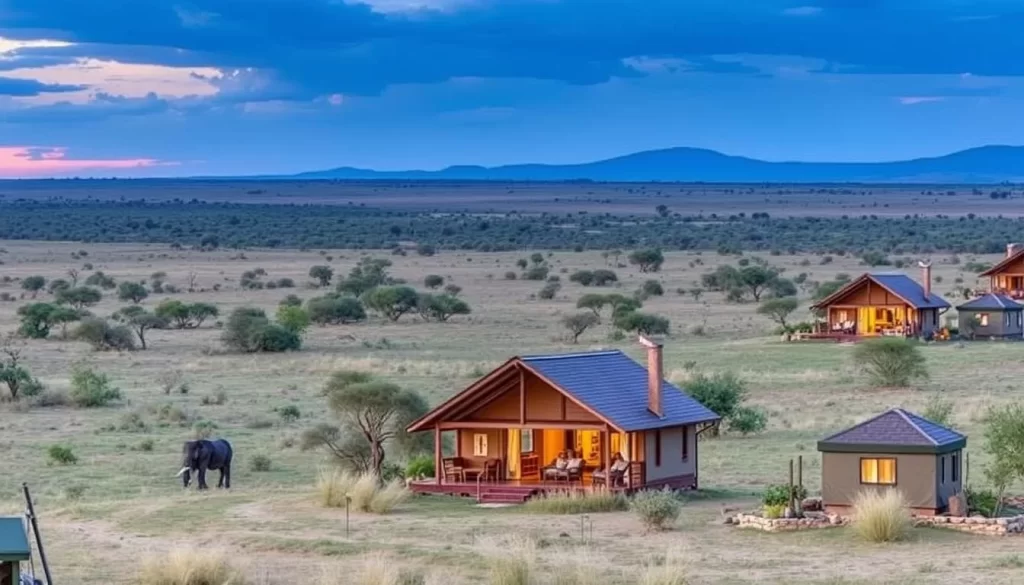
Luxury Lodges and Tented Camps
For those seeking a luxurious safari experience, Serengeti is home to high-end lodges and tented camps. Places like Four Seasons Safari Lodge offer top-notch amenities and services, ensuring a comfortable and indulgent stay. These luxury accommodations often feature spacious rooms, fine dining, and guided tours, making for an unforgettable safari experience.
Mid-Range Accommodation Options
Travelers looking for a balance between comfort and affordability can opt for mid-range accommodations like Angaata Seronera Camp. These pre-setup tented camps provide a more authentic safari experience while still offering necessary amenities. They are ideal for those who want to immerse themselves in nature without sacrificing comfort.
Budget-Friendly Camping Sites
For the budget-conscious traveler, public campgrounds like Seronera, Lobo, and Kogatende offer the most affordable way to experience Serengeti National Park. These campsites provide basic facilities, including toilets and showers. Visitors can choose to bring their own camping gear or join an organized camping safari where equipment is provided. Special campsites and mobile camping safaris offer more private and dynamic experiences, allowing you to spend a night under the stars in the heart of the national park.
Whether you choose to stay in a luxury lodge, a mid-range tented camp, or a budget-friendly camp, Serengeti National Park promises an unforgettable adventure. Each accommodation type offers a unique way to experience the park’s incredible wildlife and landscapes, ensuring that your stay is as memorable as your safari adventures.
Combining Serengeti with Other Tanzania Attractions
Combining Serengeti with other Tanzanian destinations creates a rich and varied safari experience. You can explore multiple national parks and enjoy diverse wildlife viewing opportunities.

Ngorongoro Crater: The Perfect Complement
The Ngorongoro Crater is a unique archaeological and wildlife site that complements a Serengeti visit perfectly. It’s the world’s largest intact caldera and is home to a diverse array of wildlife, including the Big Five. A visit to the crater provides a chance to see these animals in a stunning natural setting.
Tarangire National Park: Land of Baobabs and Elephants
Tarangire National Park is known for its majestic baobab trees and large elephant herds. The park’s landscape is dotted with these iconic trees, creating a picturesque backdrop for wildlife viewing. You can spend a day exploring the park and enjoying the scenery.
Lake Manyara: Tree-Climbing Lions and Flamingos
Lake Manyara is another national park that you can visit as part of your safari tour. The park is famous for its tree-climbing lions and is a haven for birdlife, with thousands of flamingos gathering on the lake‘s shores during the wet season. You can explore the park’s diverse habitats, including the groundwater forest and acacia woodland.
- Lake Manyara National Park packs remarkable biodiversity into its compact size.
- The park is famous for its tree-climbing lions.
- During wet seasons, the shallow Lake Manyara attracts thousands of flamingos.
Practical Tips for Your Serengeti Adventure
Before embarking on your Serengeti journey, here are some valuable tips to ensure a memorable and enjoyable experience. A well-planned safari adventure in Serengeti National Park can be a truly unforgettable experience, filled with exciting wildlife encounters and breathtaking natural beauty.
What to Pack for a Serengeti Safari
When preparing for your Serengeti safari, it’s crucial to pack the right gear. Bring comfortable clothing suitable for the climate, and don’t forget essentials like sunscreen, a hat, and binoculars for optimal game viewing. Your guide will take you on a thrilling safari adventure, but being prepared will enhance your overall experience.
Health and Safety Considerations
Your health and safety are paramount during your Serengeti adventure. Make sure you’re up-to-date on all necessary vaccinations and take preventive measures against malaria. Stay hydrated by drinking plenty of water throughout the day, especially during game drives. Be aware of your surroundings and follow your guide’s instructions to ensure a safe and enjoyable experience.
Photography Tips for Wildlife Enthusiasts
For wildlife enthusiasts and photography buffs, capturing the perfect shot is a top priority. To get the best results, bring the longest telephoto lens you can afford or rent (at least 300mm, ideally 400mm or longer) to capture close-up animals images without disturbing them. The “golden hours” around sunrise and sunset offer the best light for photography, coinciding with when animals are most active. Use fast shutter speeds (at least 1/1000 second) to freeze action, and consider using burst mode for unpredictable wildlife behavior.
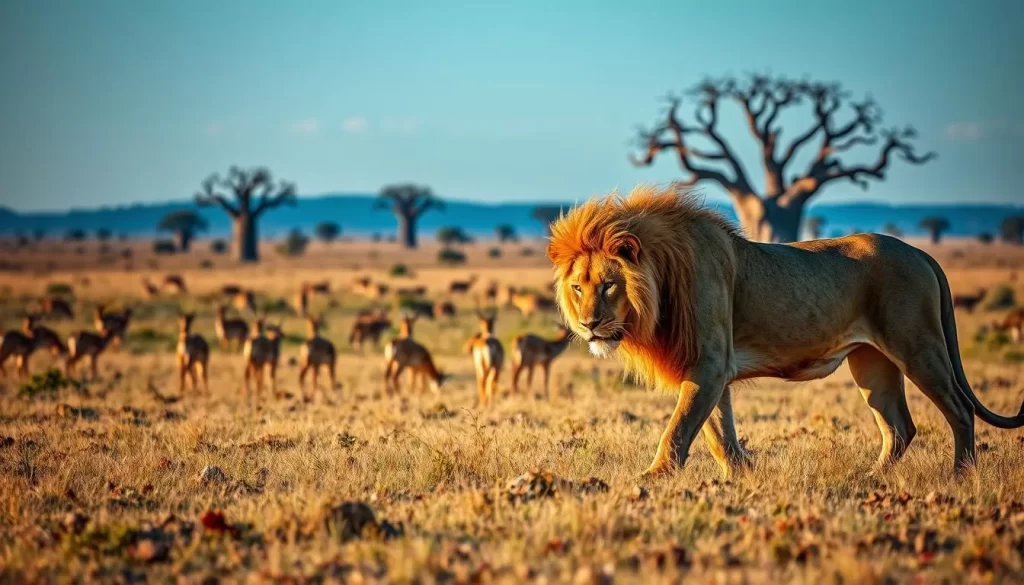
Position your vehicle with the sun behind you when possible, and communicate with your guide about optimal positioning for photography without disrupting wildlife. Don’t forget to pack adequate dust protection for your equipment, including sealable camera bags, lens cloths, and protective filters, as Serengeti’s dry season can be extremely dusty.
Choosing the Right Safari Tour for Your Needs
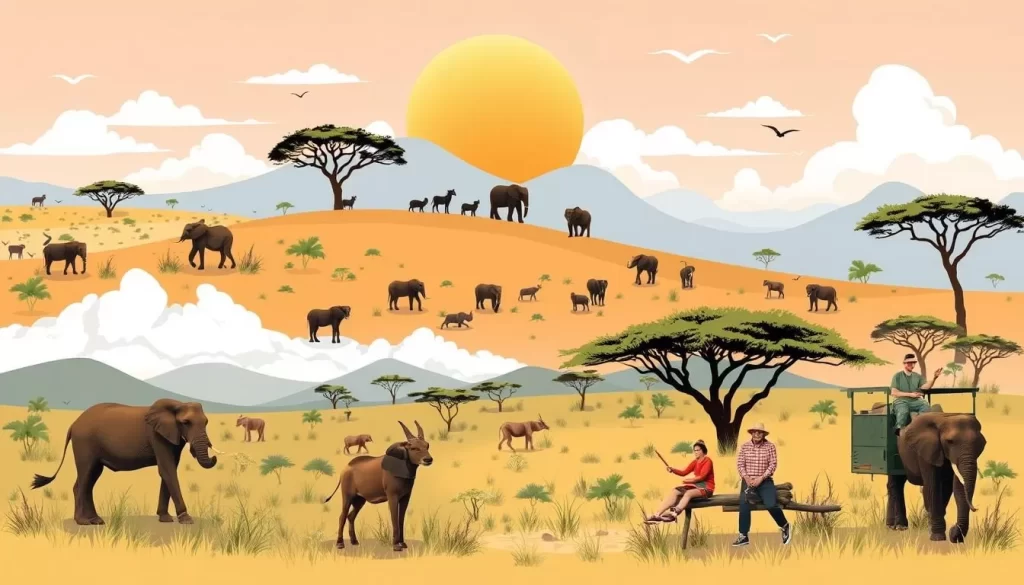
When planning your Serengeti adventure, selecting the right safari tour is crucial for an unforgettable experience. The type of tour you choose significantly influences your overall trip, from the wildlife you encounter to the comfort level of your accommodations.
Budget vs. Luxury Safari Options
Serengeti safari tours cater to a wide range of budgets, from economical options to luxury experiences. Budget-friendly tours allow you to enjoy the park’s natural beauty without breaking the bank, while luxury safaris offer high-end amenities and personalized services. Consider your priorities when deciding between these options.
For those looking to save on costs, budget tours can provide a genuine safari experience at a lower price point. On the other hand, luxury tours offer unique perks like private guides and high-end accommodations, enhancing your overall experience.
Private vs. Group Safari Experiences
Another key consideration is whether to opt for a private or group safari tour. Private safaris offer flexibility and personalized attention, allowing you to customize your daily schedule and focus on specific interests. In contrast, group safaris can be more budget-friendly and offer a social experience, as you share the adventure with fellow travelers.
The choice between private and group tours depends on your preferences regarding flexibility, budget, and social interaction. Private tours are ideal for those seeking a tailored experience, while group tours suit travelers looking for a more affordable and communal experience.
Conclusion
Serengeti National Park, Tanzania’s flagship conservation area, offers an unforgettable adventure that combines spectacular wildlife viewing, diverse landscapes, and authentic safari experiences. The park’s astonishing density of wildlife ensures a memorable experience no matter when you visit.
Whether you’re witnessing the Great Wildebeest Migration, tracking lions, or soaring above the plains in a hot air balloon, Serengeti creates lifelong memories. The park’s accessibility makes it suitable for first-time safari-goers, while its vastness ensures that even seasoned enthusiasts discover something new.
As you plan your Serengeti safari tour, remember that flexibility and patience yield the greatest rewards. Beyond the incredible wildlife encounters, a Serengeti safari offers a profound connection with nature and a chance to witness one of the planet’s last great wilderness areas.
The above is subject to change.
Check back often to TRAVEL.COM for the latest travel tips and deals.
